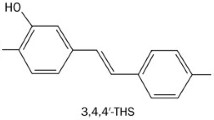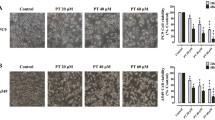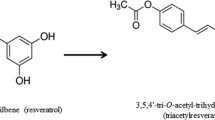Abstract
Lung adenocarcinoma is the most common subtype of non-small cell lung cancer and the leading cause of cancer death worldwide. In this study, we investigated the effect of resveratrol (Res) on lung adenocarcinoma A549 cells and its potential mechanism. We found after Res treatment, the interspace of A549 cells decreased and granular material increased in the cell nucleus. These changes were remarkably correlated with the increased concentration of Res. Res induces apoptosis in A549 cells and inhibits cell proliferation in a dose-dependent manner. We further showed that after Res treatment, expression of p53, Bax, and cleaved caspase-3 protein was dramatically up-regulated, while expression of Bcl-2 and the ratio of Bcl-2/Bax were down-regulated. Our study demonstrates that Res inhibits proliferation and induces apoptosis of A549 cells through regulation of p53, Bax, Bcl-2, and cleaved caspase-3 expression.
Similar content being viewed by others
Avoid common mistakes on your manuscript.
Introduction
Lung cancer is the leading cause of cancer death worldwide. Adenocarcinoma is the most common form of lung cancer, which has a tendency to spread to the lymph nodes [1]. Resveratrol, also known as trisphenol stilbene, is a type of strong bio-polyphenolic compounds, and mainly produced from grapes (red wine), knotweed, peanuts, mulberry and other plants [2]. It has diverse physiological and pharmacological activities and exhibits anti-cancer, chemopreventive, antiviral, cardio-protective, anti-aging, anti-nociceptive, and life-prolonging effects [3–5]. Many studies have shown that Res has significant inhibitory effect on a variety of malignant cells, such as breast cancer, stomach cancer, colon cancer, prostate cancer, leukemia, ovarian cancer, and skin cancer. It is an inhibitor of protein tyrosine kinase (PTK) [2]. Previous studies have shown that Res has good anti-tumor activity and pharmacological applications. For example, it can inhibit the growth of human lung cancer, leukemia, esophageal cancer, and breast cancer cells [6]. Although there were reports about the inhibitory effect of Res on A549 cells, comprehensive studies on how Res inhibits lung adenocarcinoma are still required [7]. Moreover, the mechanism of Res inhibition on lung adenocarcinoma is still unclear. Therefore, in this study, we investigated the effect of Res on the apoptosis of lung adenocarcinoma A549 cells. We found that Res treatment induces expression of apoptotic proteins p53, Bax, and cleaved caspase-3 while decreases expression of bcl-2 protein. Our study reveals that Res induces apoptosis of lung adenocarcinoma A549 cells.
Materials and Methods
Cells and Reagents
Low differentiated lung adenocarcinoma A549 cells were obtained from American Rockville Institute. Cells were cultured in DMEM medium containing 10 % fetal bovine serum, 100 U/mL of penicillin and streptomycin (Life Technologies). Res (R5010) was purchased from Sigma-Aldrich. DMSO was purchased from Nanjing Kezheng Chemicals Co., Ltd. Annexin V-EGFP and Western blotting kits were purchased from Nanjing KeyGEN Biotech. Co., Ltd.
Res Treatment of A549 Cells
The A549 cells in logarithmic phase were seeded on cell culture dishes. 25, 50, 100, and 200 μmol/L of Res were added to the cells when the cells reached 80 % confluence, respectively. The same volume of DMSO was added to the control cells. After 24 h treatment, the cells’ morphology was observed and recorded under an inverted phase contrast microscope.
DAPI Staining
A549 cells in logarithmic phase were seeded on 6-well plates and cultured for 24 h. The cells were treated with Res for 24 h and then fixed with 80 % alcohol for 30 min. The cells were washed with PBS once and stained with DAPI. 20 μL cell suspension was spread on slides. The slides were then covered with neutral resin, and the cells were observed under a fluorescence microscope.
MTT Assay
100 μL (1 × 105/L) of logarithmic phase A549 cells were seeded on each well of 96-well culture plates and cultured in an incubator at 37 °C with 5 % CO2. After the cells attached on the plates, cell culture medium was removed, and the medium with different concentrations of Res (0, 25, 50, 100, and 200 μmol/L) was added to the cells. There were six wells of cells used as repeats in each treatment group. DMSO-treated cells were set as the control group. The cells were incubated at 37 °C with 5 % CO2 for 24 h. 20 μL of MTT solution was then added to each well, and the cells were cultured for 4 h at 37 °C with 5 % CO2. Cell culture medium was then discarded, and 150 μL of DMSO was added to each well. Plates were shaken in dark at room temperature for 15 min. Absorbance value (A) was read at 490 nm. The inhibition rate of cell proliferation (%) was calculated as 1 − (A value of experimental group)/(A value of control group).
Western Blotting
Cells were washed with PBS for three times and lysed in cell lysis buffer (5 mL RIPA with 100 μL proteinase inhibitor cocktails and 50 μL 0.1 mol/L PMSF). Cells were disrupted with sonication at 4 °C in an ice bath. The cell lysate was centrifuged at 12,000 rpm for 10 min at 4 °C. After centrifugation, the supernatant was collected, and the protein concentration was measured. The proteins were separated by SDS-PAGE and electrically transferred to PVDF membrane. The PVDF membrane was blocked with blocking buffer with 10 % milk for 1 h, followed by the incubation with primary antibody (1:1000 dilution) overnight at 4 °C. The PVDF membrane was then washed and incubated with HRP-conjugated secondary antibody at room temperature for 1 h. The immunoreactive proteins were detected with an ECL kit.
Statistical Analysis
The statistical analysis was performed with SPSS13.0 software. Chi-square test was used to analyze the difference between groups. Pearson’s correlation was calculated. Dose–response relationship was analyzed using linear regression. The test standard α was set as 0.05.
Results
Res Treatment Changes the Morphology of A549 Cells
We first checked A549 cell morphology after Res treatment and found that it was changed after 24-h treatment. When the cells were treated with low concentration of Res, the cell size was increased, while the cell number was decreased. When the Res concentration was increased up to 200 μmol/L, marked cell apoptosis was observed. There were a large number of floating cells, and the cell density was decreased dramatically (Fig. 1).
Res Treatment Changes Cell Nucleus Morphology
DAPI is a DNA-specific dye and shows blue fluorescence after binding to DNA, which can be used to check the morphology of nuclei. As Res induces apoptosis of A549 cells, we observed the apoptosis through the morphological changes of nuclei with DAPI staining. We found that the nucleus cracking of apoptotic cells was significant, the margin of the nuclei was irregular, and nucleus debris was increased. The cell apoptosis was more significant with higher concentration Res treatment, while the cells’ nuclei were intact in the control group (Fig. 2).
Res is Cytotoxic to A549 Cells
Our results suggest that Res induces apoptosis in lung adenocarcinoma A549 cells. We next used MTT assay to accurately determine the concentration of administration. A549 cells were treated with different concentrations (0, 25, 50, 100, and 200 μmol/L) of Res, and the inhibition rates were 0, 12.4, 21.6, 51.3, and 89.7 %, respectively. Based on the linear regression of dose–response relationship y = 0.01 + 0.005x, we calculated that IC50 was 98 μmol/L (Fig. 3).
We next measured p53, Bax, and cleaved caspase-3 proteins levels after the A549 cells were treated with different concentrations of Res (0, 25, 50, 100, and 200 μmol/L) for 24 h and found that they were significantly up-regulated (Pearson correlation coefficients were 0.930 and 0.874, P < 0.001), while the expression of Bcl-2 protein was down-regulated (Fig. 4). The ratio of Bcl-2/Bax was decreased significantly (Pearson correlation coefficient 0.753, P = 0.01, Fig. 4c).
Discussion
Lung adenocarcinoma is a major subtype of non-small-cell lung carcinomas (NSCLC) and one of the most deadly human carcinomas, accounting for approximately one-third of all lung cancer cases [8]. Res is a polyphenolic phytoalexin found in plants. Studies have shown that Res can reduce the occurrence of atherosclerosis and hyperlipidemia through decreasing blood cholesterol and lipid peroxidation, therefore inhibiting platelet aggregation and preventing the formation of thrombus. Recent studies have shown that Res has anti-tumor properties. It inhibits the proliferation of human breast cancer cells, prostate cancer cells, and acute promyelocytic leukemia cells [9–11]. In certain tumors, Res has chemopreventive and chemotherapeutic effects, which may attribute to its capacity to inhibit cellular activities associated with the initiation, promotion, and progression of tumors [12]. The data from this study demonstrate that Res causes the morphological changes and inhibits the proliferation of A549 cells significantly. After being treated with different concentrations of Res, the size of A549 cells was decreased, the refractivity of the cells was reduced, and the cell morphology changed. The inhibitory effect of cells became more significant with the increasing concentration of Res. The inhibition rate was 89.7 % after the cells were treated with 200 μmol/L Res for 24 h.
p53 is a tumor suppressor gene that is involved in a variety of cellular stress and response processes through interaction with many regulatory factors and genes. p53 has various functions, such as mediating cell cycle arrest, promoting cell apoptosis, maintaining genome stability, and inhibiting tumor angiogenesis. It plays important roles in the processes of growth, development, and differentiation of tissues and cells [13]. p53 not only participates in cell cycle arrest through regulation of downstream target genes such as Cyclin B1, 14-3-3, GADD45, and b99, but also promotes apoptosis [14]. When there are excessive DNA damages that cannot be repaired, p53 will induce apoptosis to get rid of the cells with DNA damages. One mechanism of apoptosis induction is up-regulation of apoptosis-promoting factor, Bax expression, and down-regulation of apoptosis inhibitor, bcl-2 expression [15]. Our study showed that after A549 cells were treated with Res, p53 had increased expression and induced cell apoptosis through down-regulation of bcl-2 protein expression and up-regulation of Bax protein expression. The reduction of Bcl-2/Bax ratio will lead to the increase of the mitochondrial membrane permeability and release of cytochrome C, thus inducing activity of pro-apoptotic genes, caspase 3, and initiates the apoptosis program. We found that after the A549 cells were treated with Res, the cleaved caspase-3 protein was increased in a dose-dependent manner. Caspase 3 family belongs to Aspartic proteases, and mediates cell apoptosis. In this family, caspase 3 is the most important effector molecule, which induces the activation of various proteins in cells, and plays an important role in many apoptosis-related signaling transduction pathways [16, 17].
In summary, we found that Res inhibits the proliferation of A549 cells significantly, and reduces the ratio of Bcl-2/Bax through activation of p53, thus activates the caspase-3-dependent apoptotic cascade and induces apoptosis. Our study confirmed that Res is a new anti-cancer drug with promising future prospects. The inhibitory effect of Res on tumor cell growth provides a potential mechanism for its treatment of lung cancer.
References
Tiseo, M., Bartolotti, M., Gelsomino, F., & Ardizzoni, A. (2009). First-line treatment in advanced non-small-cell lung cancer: The emerging role of the histologic subtype. Expert Review of Anticancer Therapy, 9, 425–435. doi:10.1586/era.09.3.
Min, J. G., Zhou, Y. L., & Lv, G. R. (2013). Determination of resveratrol and 7,4′-dihydroxyflavone in Zhuang medicine Dracaema cochinchinensis bu HPLC. Chinese Journal of Information on TCM, 20, 61–63.
Movahed, A., Yu, L., Thandapilly, S. J., Louis, X. L., & Netticadan, T. (2012). Resveratrol protects adult cardiomyocytes against oxidative stress mediated cell injury. Archives of Biochemistry and Biophysics, 527, 74–80.
Pervaiz, S. (2003). Resveratrol: From grapevines to mammalian biology. FASEB Journal, 17, 1975–1985.
Valenzano, D. R., Terzibasi, E., Genade, T., Cattaneo, A., Domenici, L., & Cellerino, A. (2006). Resveratrol prolongs lifespan and retards the onset of age-related markers in a short-lived vertebrate. Current Biology, 16, 296–300.
Athar, M., Back, J. H., Kopelovich, L., et al. (2009). Multiple molecular targets of Resveratrol: Anti-carcinogenic mechanisms. Archives of Biochemistry and Biophysics, 486(2), 95–102.
Huang, N., Lu, H., Chang, L., Zhang, H., Zhang, H., & Li, G. (2010). [Resveratrol inhibits EGF-induced invasion of human lung adenocarcinoma A549 cells]. Zhongguo Fei Ai Za Zhi, 13(4), 287–291.
Liu, S., Li, Y., Qi, W., et al. (2014). Expression of Tiam1 predicts lymph node metastasis and poor survival of lung adenocarcinoma patients. Diagnosis Pathology, 9, 69. doi:10.1186/1746-1596-9-69.
Lee-Chang, C., Bodogai, M., Martin-Montalvo, A., et al. (2013). Inhibition of breast cancer metastasis by resveratrol-mediated inactivation of tumor-evoked regulatory B cells[J]. Journal of Immunology, 191(8), 4141–4151.
Sheth, S., Jajoo, S., Kaur, T., et al. (2012). Resveratrol reduces prostate cancer growth and metastasis by inhibiting the Akt/MicroRNA-21 pathway[J]. PLoS One, 7(12), e51655.
Ge, J., Liu, Y., Li, Q., et al. (2013). Resveratrol induces apoptosis and autophagy in T-cell acute lymphoblastic leukemia cells by inhibiting Akt/mTOR and activating p38-MAPK.[J]. Biomedical and Environmental Sciences, 26(11), 902–911.
Jang, M., Cai, L., Udeani, G. O., et al. (1997). Cancer chemopreventive activity of resveratrol, a natural product derived from grapes. Science, 275, 218–220.
Smith, N. D., Rubenstein, J. N., Eggener, S. E., et al. (2003). The p53 tumor suppressor gene and nuclear protein: Basic science review and relevance in the management of bladder cancer[J]. Journal of Urology, 169(4), 1219–1228.
Delia, D., Fontanella, E., Ferrario, C., et al. (2003). DNA damage-induced cell cycle phase regulation of p53 and p21waf1 in normal and ATM-defective cells[J]. Oncogene, 22(49), 7866–7869.
Renton, A., Llanos, S., & Lu, X. (2003). Hypoxia induces p53 through a pathway distinct from most DNA-damaging and stress-inducing agents[J]. Carcinogenesis, 24(7), 1177–1182.
Harvey, N. L., & Kumar, S. (1998). The role of caspase in apoptosis[J]. Advances in Biochemical Engineering/Biotechnology, 62, 107–128.
Ray, R. M., Bhattacharya, S., & Johnson, L. R. (2011). Mdm2 inhibition induces apoptosis in p53 deficient human colon cancer cells by activating p73- and E2F1-mediated expression of PUMA and Siva-1[J]. Apoptosis, 16(1), 35–44.
Author information
Authors and Affiliations
Corresponding author
Rights and permissions
About this article
Cite this article
Wang, X., Wang, D. & Zhao, Y. Effect and Mechanism of Resveratrol on the Apoptosis of Lung Adenocarcinoma Cell Line A549. Cell Biochem Biophys 73, 527–531 (2015). https://doi.org/10.1007/s12013-015-0696-3
Published:
Issue Date:
DOI: https://doi.org/10.1007/s12013-015-0696-3








